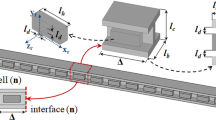Abstract
The main focus of the paper is the development of technological process for the production of complex 3D microstructure, from designing it by using computer generated holography to its physical 3D patterning by exploiting the process of electron beam lithography. The logo image was chosen for numerical generation, which was performed by using Gerchberg–Saxton algorithm for computer generated hologram design. Physical implementation of microstructure was performed by using a single layer polymethyl methacrylate (PMMA) as a basis for 3D microstructure, which was exposed by using e-beam lithography system e-LINEplus. After production, verification of 3D microstructure is performed by exposing it under the laser beam and qualitative analysis is performed by using atomic force microscope. Finally, improvement of mass production of complex microstructures, designed by using computer generated holography, is presented.
Access this chapter
Tax calculation will be finalised at checkout
Purchases are for personal use only
Similar content being viewed by others
References
Wilson LW et al (1998) High density, high performance optical data storage via volume holography: viability at last? Opt Quantum Electron 32:393–404
Gren P (2003) Four-pulse interferometric recordings of transient events by pulsed TV holography. Opt Lasers Eng 40:517–528
Saari P, Kaarli R, Ratsep M (1992) Temporally multiplexed fourier holography and pattern recognition of femtosecond-duration images. J Lumin 56:175–180
Nishchal KN, Joseph J, Singh K (2004) Fully phase encryption using digital holography. Opt Eng 43:2959–2966
Son YJ, Javidi B, Kwack DK (2006) Methods for displaying three-dimensional images. Proc IEEE 94:502–523
Krauss PR, Chou YS (1997) Nano-compact disks with 400 Gbit/in2 storage density fabricated using nanoimprint lithography and read with proximal probe. Appl Phys Lett 71:3174–3176
Lee JL et al (2001) Design and fabrication of CD-like microfluidic platforms for diagnostics: polymer based microfabrication. Biomed Microdevice 3(4):339–351
Jaszewski WR et al (1998) Hot embossing in polymers as a direct way to pattern resist. Microelectron Eng 41–42:575–578
Mekaru H, Goto H, Takahashi M (2007) Development of ultrasonic micro hot embossing technology. Microelectron Eng 84:1282–1287. doi:10.5772/8191
Hirai Y, Yoshida S, Takagi N (2003) Defect analysis in thermal nanoimprint lithography. J Vac Sci Technol B 21(6):2765–2770
Narijauskaitė B et al (2011) High-frequency excitation for thermal imprint of microstructures into a polymer. Experimental techniques. Published online 11 Apr 2011. http://onlinelibrary.wiley.com/enhanced/doi/10.1111/j.1747-1567.2011.00724.x/
Liu C et al (2010) Deformation behavior of solid polymer during hot embossing process. Microelectron Eng 87:200–207. doi:10.1016/j.mee.2009.07.014
Li MJ, Liu C, Peng J (2008) Effect of hot embossing process parameters on polymer flow and microchannel accuracy produced without vacuum. J Mater Process Technol 207:163–171
Yao GD, Vinayshankar VL, Byung K (2005) Study on sequeezing Flow during nonisothermal embossing of polymer microstructure. J Polym Eng Sci 45:652–660
Lin RC, Chen HR, Chen HC (2003) Preventing non-uniform shrinkage in ope-die hot embossing of PMMA microstructures. J Mater Process Technol 140:173–178
Ermakov V, Kruchinin S, Fujiwara A (2008) Electronic nanosensors based on nanotransistor with bistability behaviour. In: Bonca J, Kruchinin S (eds) Proceedings NATO ARW “Electron transport in nanosystems”. Springer, Berlin, p 341–349
Kruchinin S, Pruschke T (2012) Thermopower for a molecule with vibrational degrees of freedom. Phys Lett A 378:157–161 (2014)
Narijauskaitė B, Palevičius A, Narmontas P, Ragulskis M, Janušas G. High-frequency excitation for thermal imprint of microstructures into a polymer. Exp Tech X(X):1–7
Šakalys R, Janušas G, Palevičius A, Bendikienė R, Palevičius R (2015) Microstructure replication using high frequency vibroactive pad. Mechanika 21(2):5–12
Popov E (2012) Gratings: theory and numeric applications. Institut Fresnel, Université d’Aix Marseille, CNRS., 1st edn. Presses universitaires de Provence (PUP)
Acknowledgements
This research was funded by a grant (No. MIP-026/2014) from the Research Council of Lithuania.
Author information
Authors and Affiliations
Editor information
Editors and Affiliations
Rights and permissions
Copyright information
© 2016 Springer Science+Business Media Dordrecht
About this paper
Cite this paper
Šakalys, R., Janušas, G., Palevičius, A., Grigaliūnas, V., Palevičius, P. (2016). Vibration Based Microstructure Replication and Analysis. In: Bonča, J., Kruchinin, S. (eds) Nanomaterials for Security. NATO Science for Peace and Security Series A: Chemistry and Biology. Springer, Dordrecht. https://doi.org/10.1007/978-94-017-7593-9_13
Download citation
DOI: https://doi.org/10.1007/978-94-017-7593-9_13
Published:
Publisher Name: Springer, Dordrecht
Print ISBN: 978-94-017-7591-5
Online ISBN: 978-94-017-7593-9
eBook Packages: Biomedical and Life SciencesBiomedical and Life Sciences (R0)




